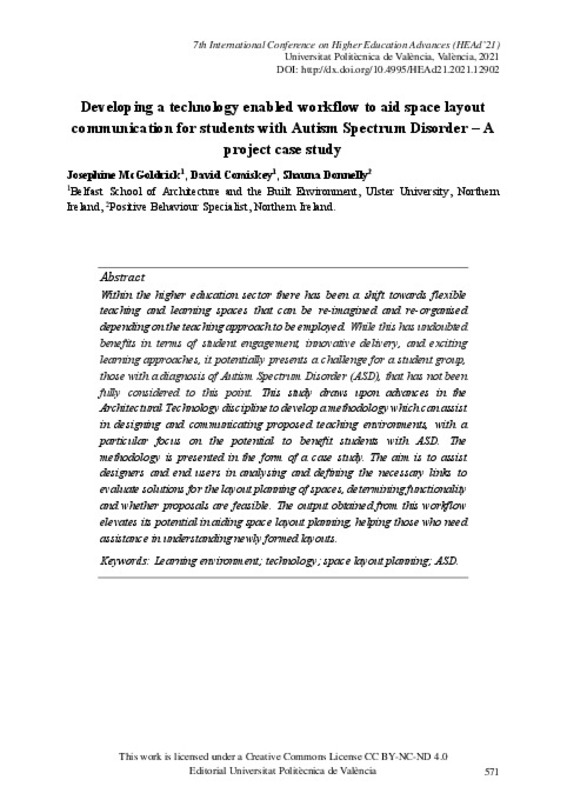JavaScript is disabled for your browser. Some features of this site may not work without it.
Buscar en RiuNet
Listar
Mi cuenta
Estadísticas
Ayuda RiuNet
Admin. UPV
Developing a technology enabled workflow to aid space layout communication for students with Autism Spectrum Disorder - A project case study
Mostrar el registro sencillo del ítem
Ficheros en el ítem
| dc.contributor.author | McGoldrick, Josephine
|
es_ES |
| dc.contributor.author | Comiskey, David
|
es_ES |
| dc.contributor.author | Donnelly, Shauna
|
es_ES |
| dc.date.accessioned | 2021-09-13T07:27:53Z | |
| dc.date.available | 2021-09-13T07:27:53Z | |
| dc.date.issued | 2021-07-26 | |
| dc.identifier.isbn | 9788490489758 | |
| dc.identifier.issn | 2603-5871 | |
| dc.identifier.uri | http://hdl.handle.net/10251/172165 | |
| dc.description.abstract | [EN] Within the higher education sector there has been a shift towards flexible teaching and learning spaces that can be re-imagined and re-organised depending on the teaching approach to be employed. While this has undoubted benefits in terms of student engagement, innovative delivery, and exciting learning approaches, it potentially presents a challenge for a student group, those with a diagnosis of Autism Spectrum Disorder (ASD), that has not been fully considered to this point. This study draws upon advances in the Architectural Technology discipline to develop a methodology which can assist in designing and communicating proposed teaching environments, with a particular focus on the potential to benefit students with ASD. The methodology is presented in the form of a case study. The aim is to assist designers and end users in analysing and defining the necessary links to evaluate solutions for the layout planning of spaces, determining functionality and whether proposals are feasible. The output obtained from this workflow elevates its potential in aiding space layout planning, helping those who need assistance in understanding newly formed layouts. | es_ES |
| dc.description.sponsorship | This work has been developed from an undergraduate student research paper. The authors would like to thank Leica Geosystems for making the laser scan and initial model available for use. We would also like to thank Dalux for their assistance in the use of their platform. | es_ES |
| dc.format.extent | 9 | es_ES |
| dc.language | Inglés | es_ES |
| dc.publisher | Editorial Universitat Politècnica de València | es_ES |
| dc.relation.ispartof | 7th International Conference on Higher Education Advances (HEAd'21) | |
| dc.rights | Reconocimiento - No comercial - Sin obra derivada (by-nc-nd) | es_ES |
| dc.subject | Higher Education | es_ES |
| dc.subject | Learning | es_ES |
| dc.subject | Educational systems | es_ES |
| dc.subject | Teaching | es_ES |
| dc.subject | Learning environment | es_ES |
| dc.subject | Technology | es_ES |
| dc.subject | Space layout planning | es_ES |
| dc.subject | ASD | es_ES |
| dc.title | Developing a technology enabled workflow to aid space layout communication for students with Autism Spectrum Disorder - A project case study | es_ES |
| dc.type | Capítulo de libro | es_ES |
| dc.type | Comunicación en congreso | es_ES |
| dc.identifier.doi | 10.4995/HEAd21.2021.12902 | |
| dc.rights.accessRights | Abierto | es_ES |
| dc.description.bibliographicCitation | Mcgoldrick, J.; Comiskey, D.; Donnelly, S. (2021). Developing a technology enabled workflow to aid space layout communication for students with Autism Spectrum Disorder - A project case study. En 7th International Conference on Higher Education Advances (HEAd'21). Editorial Universitat Politècnica de València. 571-579. https://doi.org/10.4995/HEAd21.2021.12902 | es_ES |
| dc.description.accrualMethod | OCS | es_ES |
| dc.relation.conferencename | Seventh International Conference on Higher Education Advances | es_ES |
| dc.relation.conferencedate | Junio 22-23, 2021 | es_ES |
| dc.relation.conferenceplace | València, Spain | es_ES |
| dc.relation.publisherversion | http://ocs.editorial.upv.es/index.php/HEAD/HEAd21/paper/view/12902 | es_ES |
| dc.description.upvformatpinicio | 571 | es_ES |
| dc.description.upvformatpfin | 579 | es_ES |
| dc.type.version | info:eu-repo/semantics/publishedVersion | es_ES |
| dc.relation.pasarela | OCS\12902 | es_ES |








